Introduction
In evolutionary terms the ancient Egyptians had only just emerged from the stone age.
The change comes a mere 10,000 years ago, when people first discover how to cultivate crops and to domesticate animals. This is the most significant single development in human history. It happens within the Stone Age, for tools are still flint rather than metal, but it is the dividing line which separates the old Stone Age (palaeolithic) from the new Stone Age (neolithic). It has been aptly called the Neolithic Revolution. The first farmers emerged about 8,000 years ago.[1]
Keeping in mind the statement above regarding the evolution of man, let us examine just eight examples of the many that exist of ancient Egyptian technology which cannot be, or can only be repeated today with great difficulty.
Example 1. The great pyramid of Khufu (Cheops is his Greek name)
This pyramid is the largest construction on the face of the earth. The precision of the design and the perfection of its construction has always fascinated scholars and visitors. A 146 meters (479 feet) tall limestone building, its sides rise at an angle of 51°52′, and a base of 230 meters (754 feet), consisting of around 23 million blocks which were cut, transported, and assembled to create the Khufu Pyramid. It weighs 5.75 million tons. 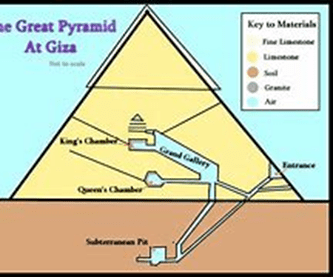 Its entrance is on the north side comprising a shaft which descends from it through to the pyramid interior. It breaks through the rocky soil beneath the pyramid and ends in an unfinished chamber. From this chamber, there is an ascending passage to another room called, Queen’s Chamber, and a great gallery finished with red granite. At the upper end of the gallery, a narrow passage leads to a burial room, which is the King’s Chamber. Two narrow shafts obliquely run from this room through the structure of the pyramid, to its outside as shown.
Its entrance is on the north side comprising a shaft which descends from it through to the pyramid interior. It breaks through the rocky soil beneath the pyramid and ends in an unfinished chamber. From this chamber, there is an ascending passage to another room called, Queen’s Chamber, and a great gallery finished with red granite. At the upper end of the gallery, a narrow passage leads to a burial room, which is the King’s Chamber. Two narrow shafts obliquely run from this room through the structure of the pyramid, to its outside as shown.
Remarkably, the pyramid has eight sides, but this can only be seen when the sun is at a specific angle, and it is viewed from above as the image shows. This feature is due to each side being slightly concaved, making this pyramid a true marvel of precision engineering.
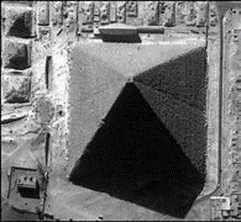 These statistics are truly staggering. It is thought that it was constructed in 2570 BC. Egyptologist Brien Foerster, sums up the problem of its construction rather succinctly in his book, Lost Ancient Technology of Egypt with these words: The smallest blocks weigh a ton, while the average block weighs 2.5 tons up to even 70 tons. How could the Egyptians lift these very heavy blocks with such precision to the height of a forty-story building? Although there are some theories, we do not know for sure. The massive construction of the pyramid is also aligned with a precision on only 3 minutes and 6 second off perfect alignment to the 4 cardinal points.
These statistics are truly staggering. It is thought that it was constructed in 2570 BC. Egyptologist Brien Foerster, sums up the problem of its construction rather succinctly in his book, Lost Ancient Technology of Egypt with these words: The smallest blocks weigh a ton, while the average block weighs 2.5 tons up to even 70 tons. How could the Egyptians lift these very heavy blocks with such precision to the height of a forty-story building? Although there are some theories, we do not know for sure. The massive construction of the pyramid is also aligned with a precision on only 3 minutes and 6 second off perfect alignment to the 4 cardinal points.
Example 2. Precisely cut stones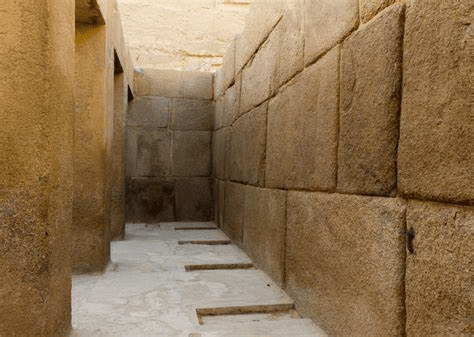
How did ancient people cut these huge red granite stones to fit together seamlessly to form a strong wall without mortar? This example is from the valley temple of Khafre constructed in 2472-2448 BC
Example 3. Massive precisely cut stone boxes
Located northwest of the Pyramid of Djoser at Saqqara, are the Serapeum (boxes) of Saqqara. Ever since their discovery in 1850 by Auguste Mariette, the Serapeum which appear to be for the internment of Apis bulls, has puzzled archaeologists and researchers and the kilometres of tunnels that have been unearthed since, have been the subject of debate among many. This majestic ancient labyrinth is home to 25 megalithic stone (hard stone; granite, basalt, diorite, etc.) ‘boxes’, each weighing between 70 and 100 tons. Image credit: Pinterest. Ancient Egyptians, the builders of these magnificent ‘boxes’ possessed manufacturing capabilities beyond our understanding. Engineer and archaeologist Chris Dunn[2] comments: In 1995, I inspected the inside and outside surfaces of two boxes in the Serapeum with a 6-inch precision straight edge that was accurate to .0002 inch. In one of the crypts there is a granite 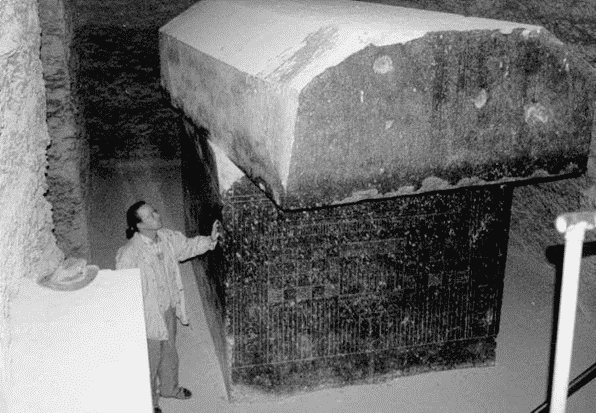 box with a broken corner (pictured and Picture credit: Pinterest) and this box is accessible by means of steps down to the lower floor. The outside of the box appears to be roughly finished, but the glint of a high polish on the inside surfaces beckoned me to climb inside. Running my hand along the surface of the granite reminded me of the thousands of times I have run my hand along a granite surface plate when I was working as a machinist and later as a tool and die maker. The feel of the stone was no different, though I was not sure of its flatness or accuracy. To check my impression, I placed the edge of my precision-ground parallel against the surface—and I saw that it was dead flat. There was no light showing through the interface of the steel and the stone, as there would be if the surface was concave, and the steel did not rock back and forth, as it would if the surface was convex.
box with a broken corner (pictured and Picture credit: Pinterest) and this box is accessible by means of steps down to the lower floor. The outside of the box appears to be roughly finished, but the glint of a high polish on the inside surfaces beckoned me to climb inside. Running my hand along the surface of the granite reminded me of the thousands of times I have run my hand along a granite surface plate when I was working as a machinist and later as a tool and die maker. The feel of the stone was no different, though I was not sure of its flatness or accuracy. To check my impression, I placed the edge of my precision-ground parallel against the surface—and I saw that it was dead flat. There was no light showing through the interface of the steel and the stone, as there would be if the surface was concave, and the steel did not rock back and forth, as it would if the surface was convex.
I slid the parallel along the surface both horizontally and vertically, and there was no deviation from a true, flat surface. The flatness was similar to precision-ground surface plates that are used in manufacturing for the verification of exactly machined parts for tools, gauges, and myriad other products that require extremely accurate surfaces and dimensions. Those familiar with such products and the relationship between gauges and surface plates know that the gauge may show that the stone is flat within the tolerance of the gauge—in this case 0.0002-inch (0.00508 millimetre) flatness.
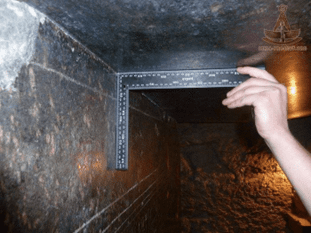 I was also impressed to find that each corner of the box had a small radius (he later measured it to be exactly 4 mm)[3] all the way through the box that ran from the top of the box to the bottom, where it blended with the corner radius of the floor of the box.
I was also impressed to find that each corner of the box had a small radius (he later measured it to be exactly 4 mm)[3] all the way through the box that ran from the top of the box to the bottom, where it blended with the corner radius of the floor of the box.
The underside of the 27 ton lid and the inside wall of the box I found to be square and finding that the squareness was achieved not just on one side of the box but both, raises the level of difficulty in accomplishing this feat.
He concludes with: The artifacts I have measured in Egypt have the marks of careful and remarkable manufacturing methods. They are unmistakable and irrefutable in their precision. The precision square I used was calibrated to .00005 inch (that is 5/100,000 of an inch) using a Jones & Lamson comparitor. To put it mildly, I was astounded. I did not expect to find such exactitude.
The boxes are clearly from antiquity, but nobody can say when they were made.
Example 4. Senusret II’s sarcophagus
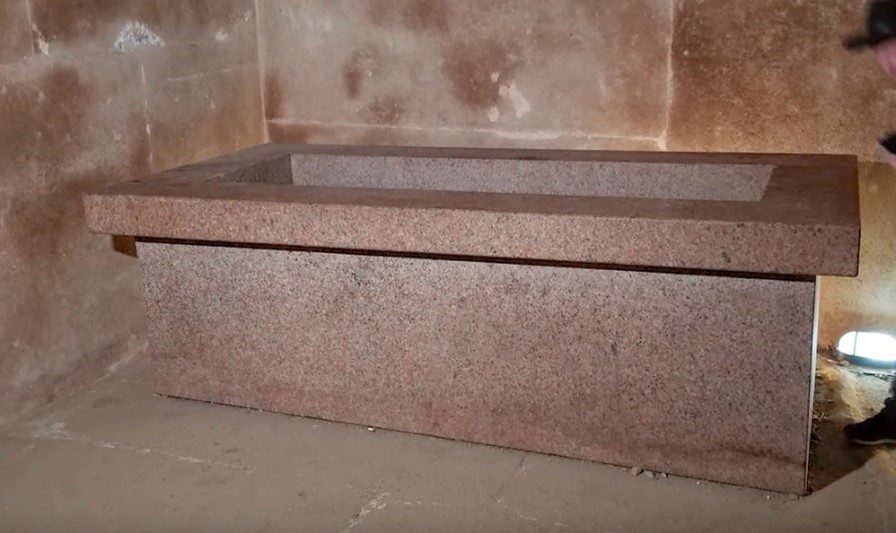 There are some remarkable stone objects of ancient Egypt that have been found, one of the finest is undoubtably the extremely hard red granite sarcophagus found in the underground burial chamber of the pyramid at El-Lahun, thought to be that of Senusret II who was the fourth pharaoh of the twelfth dynasty of Egypt ruling from 1897 to 1878 BC. It was first excavated by the British archaeologist Sir William Flinders Petrie in 1920. The images are of the sarcophagus which Petrie found deep in the pyramid. Image credit: https://www.abovetopsecret.com/forum/thread1290070/pg1. Petrie took measurements of the box and was staggered by its precision. The sides are parallel to within a few thousandths of an inch, likewise its flatness. As the photos show the internal radius of its corners are only a few millimetres. As well, all its external edges have a precise bevel. It appears not to have been polished, but its finish is that of the cutting procedure. Since this box was made from a single piece of granite, one mistake would have ruined it.
There are some remarkable stone objects of ancient Egypt that have been found, one of the finest is undoubtably the extremely hard red granite sarcophagus found in the underground burial chamber of the pyramid at El-Lahun, thought to be that of Senusret II who was the fourth pharaoh of the twelfth dynasty of Egypt ruling from 1897 to 1878 BC. It was first excavated by the British archaeologist Sir William Flinders Petrie in 1920. The images are of the sarcophagus which Petrie found deep in the pyramid. Image credit: https://www.abovetopsecret.com/forum/thread1290070/pg1. Petrie took measurements of the box and was staggered by its precision. The sides are parallel to within a few thousandths of an inch, likewise its flatness. As the photos show the internal radius of its corners are only a few millimetres. As well, all its external edges have a precise bevel. It appears not to have been polished, but its finish is that of the cutting procedure. Since this box was made from a single piece of granite, one mistake would have ruined it.
It is worked so precisely everywhere, that Petrie concluded that the minor errors he measured were probably due to his own limitations. photo credit: Alamy.
Example 5. The holes bored into granite
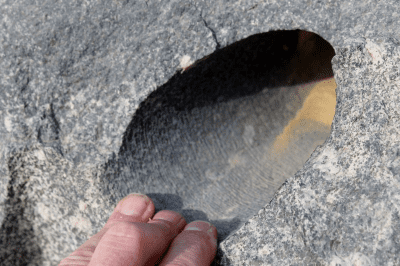 This closeup photo of a hole bored into black granite at Abusir reveals the grooves made as the tube drill easily cut through the hard granite. Each revolution of the drill bit appears to have penetrated up to 2 mm (more than 1/16 of an inch) into the granite, which is astonishing, even when compared with what modern drills can do. Whatever this ancient technology was, it was able to cut into this hard stone (Mohs number 7 compared with iron of 4.5)[4] more efficiently than modern equipment, not necessarily faster but more efficiently.[5] Photo credit: https://hiddenincatours.com/lost-ancient-technology-of-egypt-curious-drill-holes-in-stone.
This closeup photo of a hole bored into black granite at Abusir reveals the grooves made as the tube drill easily cut through the hard granite. Each revolution of the drill bit appears to have penetrated up to 2 mm (more than 1/16 of an inch) into the granite, which is astonishing, even when compared with what modern drills can do. Whatever this ancient technology was, it was able to cut into this hard stone (Mohs number 7 compared with iron of 4.5)[4] more efficiently than modern equipment, not necessarily faster but more efficiently.[5] Photo credit: https://hiddenincatours.com/lost-ancient-technology-of-egypt-curious-drill-holes-in-stone.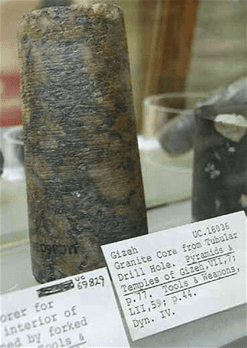
There exist many holes bored into granite in and around the sites of ancient Egypt.
The drill hole cores were presumably discarded after drilling. Some were collected and are on display as shown, in the Petrie Museum, London. Engineer, Christopher Dunn after studying the drill cores, had this to say:
The most fascinating feature of the granite core Petrie describes, is the spiral groove around the core indicating a feed rate of 0.100 inch per revolution of the drill. It was 500 times greater than modern diamond drills, but the rotation of the drill would not have been as fast as the modern drill’s 900 revolutions per minute.
Example 6. Millions of hard stones cut by a saw
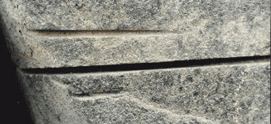 Many millions of stones were cut by the ancient Egyptians for the construction of pyramids and statues. The evidence points to the fact that these very large granite and limestone rocks were cut by a mechanical saw. Not only their precise size so that they fit almost seamlessly together when used in buildings, but they have saw marks on their faces. The thickness of the saw blade used can be ascertained from cuts in some basalt rocks as shown. Basalt has a Mohs rating of 6. These examples are from Giza and appear to be over cuts. Note, the pyramids and other constructions at Giza are among the oldest of Egyptian remnants. Picture credit: Spirit and Stone.
Many millions of stones were cut by the ancient Egyptians for the construction of pyramids and statues. The evidence points to the fact that these very large granite and limestone rocks were cut by a mechanical saw. Not only their precise size so that they fit almost seamlessly together when used in buildings, but they have saw marks on their faces. The thickness of the saw blade used can be ascertained from cuts in some basalt rocks as shown. Basalt has a Mohs rating of 6. These examples are from Giza and appear to be over cuts. Note, the pyramids and other constructions at Giza are among the oldest of Egyptian remnants. Picture credit: Spirit and Stone.
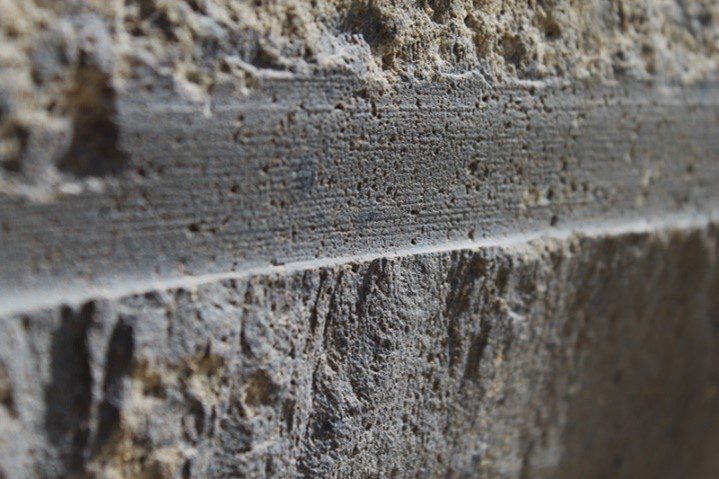 In the other picture, not only is the saw cut well defined, but so are the striation marks of the blade used. Picture credit: https://hiddenincatours.com/evidence-of-ancient-machining-technology-on-the-giza-plateau-of-egypt.
In the other picture, not only is the saw cut well defined, but so are the striation marks of the blade used. Picture credit: https://hiddenincatours.com/evidence-of-ancient-machining-technology-on-the-giza-plateau-of-egypt.
Acclaimed archaeologist Sir William Flinders Petrie stated in his 1883 book, The Pyramids, and Temples of Gizeh stated:We therefore need to have no hesitation in allowing that the graving out of lines in hard stone by jewelled points was a well-known art. And when we find on the surfaces of the saw cuts in diorite, groves as deep as 1/100th of an inch, it appears far more likely that such were produced by fixed jewel points in the saw, than any fortuitous rubbing about of a loose powder.[6]
Example 7. The precise face and head dress of Ramses.
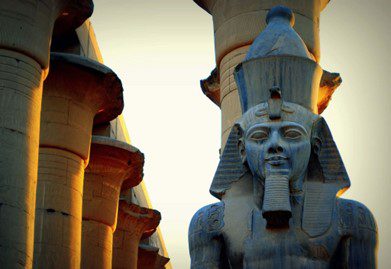 Engineer, Christopher Dunn took photographs of the head portion of four statues of Ramses II (ca 1303 BC – 1213 BC), there are about 100 in all. To take the photos, he secured his camera on a tripod to eliminate any movement that could blur the picture.
Engineer, Christopher Dunn took photographs of the head portion of four statues of Ramses II (ca 1303 BC – 1213 BC), there are about 100 in all. To take the photos, he secured his camera on a tripod to eliminate any movement that could blur the picture.
The four statues he photographed are, (1) in the Ramses Hall in the Temple of Luxor, (2) the bust outside the Temple of Luxor, (3) Memphis and (4) the Ramesseum Ramses. He then downloaded the images into his computer and using a specific software program, he made precise measurements and found each head to be perfectly symmetrical with one side of the face being a mirror image of the other. The shape and the positioning of each facial feature obeyed Pythagorean law and are consistent with Fibonacci series. As an engineer, he was staggered by the precision of these busts and overwhelmed by the fact that they were carved from one piece of stone. The statue shown is at the Luxor temple. The Memphis statue is lying on its back and has been calculated to weigh 300 tons. This one was made from the softer limestone, but the others were carved into granite. The colossal statue of Ramses at his mortuary Temple at Ramesseum originally stood at 18 metres high. Some event caused the head to break off and fall to the ground. This by itself weighs seven tons. It was originally made from one piece of the very hard red granite.
After studying the precision of each face and particularly how each mouth had been made, he concluded: It has become clear that these statues must have been cut with the assistance of mechanical devices that cause the cutting tool to move along pre-determined boundaries to produce an accurate representation in granite of the specific design. He has spent a lot of ink in his 2010 book: Lost Technologies of Ancient Egypt, explaining the almost unattainable precision of these busts.
Example 7. The statue of Khafre seated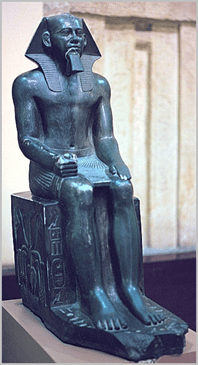
Khafre was pharaoh during the fourth dynasty which is thought to have ranged from 2620 to 2494 BC. His, is the second largest pyramid on the Giza Plateau. The largest is that of Khufu, his father, which is shown in example 1. This statue of the pharaoh seated, was discovered under a pit in Khafre’s valley temple. What is remarkable is that it has been sculptured from one piece of a very hard form of granite called diorite.
The question that the statue prompts is, how was it sculpted with so much detail and with such a smooth surface especially when considering that diorite has a Mohs value of 7 with iron being 4.5. So, it would have been easier for the ancient Egyptians to have sculpted the statue from iron.
The Khafre statue is on display at the Egyptian Museum in Cairo.
Example 8. The sun shining on Ramses’ face
Rameses II (1303 – 1213 BC) was the third pharaoh of Egypt’s 19th Dynasty. He was regarded as the most powerful and celebrated pharaoh of Egypt and was the husband of the famous Queen Nefertari.
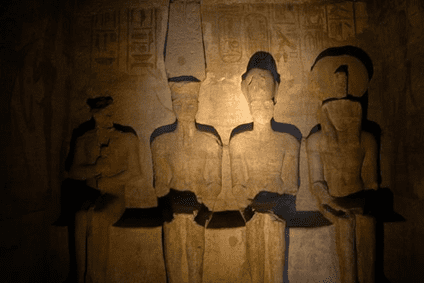 The Abu Simbel temple was constructed by the ancient Egyptians so that the sun would shine on the face of a statue of Rameses twice per year, on his birthday and on the anniversary of his coronation as pharaoh. His statue is one of four statues placed 65 metres inside the temple at the end of a long corridor. Accordingly, the sun would shine on his face at 6:25 am on February 21 and at 5:53 am on October 21 every year. At these times, his face was illuminated for about 20 minutes. But the real demonstration of advanced technology is the fact that the two days of illumination had to have been selected and determined before the temple and the statues were constructed. For this to be accomplished, its designers needed to possess a thorough knowledge of astronomy and mathematics to determine the declination of the axis of the temple from the real east; the earth is tilted on its axis of rotation at an angle of 23.5 degrees from the vertical. Also, the wonder appears at a distance of 65 meters along a tunnel cut into rock.
The Abu Simbel temple was constructed by the ancient Egyptians so that the sun would shine on the face of a statue of Rameses twice per year, on his birthday and on the anniversary of his coronation as pharaoh. His statue is one of four statues placed 65 metres inside the temple at the end of a long corridor. Accordingly, the sun would shine on his face at 6:25 am on February 21 and at 5:53 am on October 21 every year. At these times, his face was illuminated for about 20 minutes. But the real demonstration of advanced technology is the fact that the two days of illumination had to have been selected and determined before the temple and the statues were constructed. For this to be accomplished, its designers needed to possess a thorough knowledge of astronomy and mathematics to determine the declination of the axis of the temple from the real east; the earth is tilted on its axis of rotation at an angle of 23.5 degrees from the vertical. Also, the wonder appears at a distance of 65 meters along a tunnel cut into rock.
This phenomenon was discovered in 1874 by Miss Emilda Edwards and she wrote about it in her book she had published in 1899: Thousand Mile on the River Nile.
The statues consist of, from the left, the god Ra Hor, the god Amun, Ramses and the god Ptah.
The construction of the Aswan Dam meant that the Abu Simbel temple would be under water when the dam filled, so an international effort was undertaken to shift the whole temple complex to higher ground, and this herculean effort was completed successfully in 1968. But they could not reconstruct it so that the sun would shine on Ramses face on the correct two days of the year; they were one day out. The sun shines now on Ramses face on February 22 and October 22. Interestingly, Wikipedia makes the comment: the current alignment may not be as precise as the original one.[7]
Dates
It is difficult to be certain of the dates of the reigns of the pharaohs as there is not a single line of descension. This is due to the fact, that at times during the rule of the pharaohs Egypt was divided into Upper and Lower Egypt and for a short time, Middle Egypt as well. This division meant that there were up to three pharaohs ruling at the same time. And, at times there were co-regencies and some pharaohs had more than one name. All of this combined to stretch the pharaonic period. The dates given here are those generally used in the literature but may be slightly out.
The times of the reigns of the later pharaohs are known better. When Greece became a world power under Alexander the Great, one of his generals Ptolemy, took control of North Africa including Egypt, and made himself Pharaoh. This started a line of Ptolemy pharaohs right through to Ptolemy XV who ruled from 44-30 BC.
The time of pharaoh Shishak can be ascertained with certainty because he is mentioned in the Bible during the end of Solomon’s reign (1 Kings 11:40; 14:25; 2 Chronicles 12:2-4), which will fix it to around 926 BC, the year he plundered Jerusalem temple.
Summary
Brien Foerster identifies the enigma of ancient Egyptian technology on the back cover of his book, Lost ancient technology of Egypt where he states: Based on the observations of modern engineers, geologists and other experts, and the on-site experiences of the author, it seems clear that a much older civilisation once existed especially in the Giza Plateau area, and had technology that rivalled, and in some cases `exceeded our own.
Engineer Christopher Dunn who had studied the artifacts of ancient Egypt for decades, concurs: I am compelled to suggest that the ancient Egyptians had to have used sophisticated machines that cut diorite and granite with little difficulty. The evidence suggests that they had lathes and that lathes were built with precise bearings that regulated the rotation of the spindle. The contoured blocks on the Giza Plateau suggests that they had machines that cut exact, three-dimensional shapes on three axes.[8]
There is an interesting theme running through the stunning technologies of ancient Egypt and this is, that the greatest technologies and engineering feats all appear to be in the oldest constructions and the less impressive in the younger works.
Foerster makes this point: The quality of construction of Abusir pyramids is inferior to those presumed to have been of the fourth dynasty; perhaps signalling a decrease in royal power or a less vibrant economy. They are smaller than their predecessors and are built of low quality local stone.
There is no doubt that the ancient Egyptians possessed technology that would rival what we have today, and this is abundantly clear from an examination of the relicts that have survived. And that during the pharaonic period they seem to have started to lose it.
A biblical explanation
It is clear from scripture that mankind was created with intelligence from the beginning. The Bible states (Genesis 4:21-22) that Jubal was the father of all who played the harp and flute. And that Tubal-Cain forged all kinds of tools out of bronze and iron. Jubal and Tubal-Cain were only seven from Adam, in fact, Adam was still alive when both these men were living.
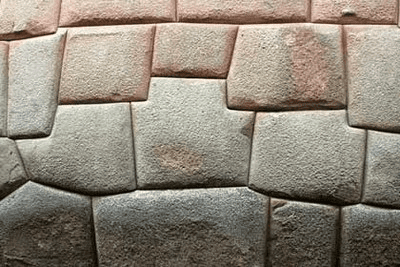 It was not only the ancient Egyptians who demonstrated high intelligence. Dr Peter Lu of Yale University, concluded from his studies, that the Chinese must have used compound machines three thousand years ago.[9] There are many ancient sites around the world where large stones are fitted together so well that even a thin knife blade cannot fit between them. The image here, is of the green andesite wall at Cusco Peru. Other examples are at Machu Picchu in Peru. Apart from Stonehenge, there is the Göbekli Tepe complex in the south eastern Anatolia Region of Turkey, consisting of massive richly decorated stone pillars.
It was not only the ancient Egyptians who demonstrated high intelligence. Dr Peter Lu of Yale University, concluded from his studies, that the Chinese must have used compound machines three thousand years ago.[9] There are many ancient sites around the world where large stones are fitted together so well that even a thin knife blade cannot fit between them. The image here, is of the green andesite wall at Cusco Peru. Other examples are at Machu Picchu in Peru. Apart from Stonehenge, there is the Göbekli Tepe complex in the south eastern Anatolia Region of Turkey, consisting of massive richly decorated stone pillars.
Conclusion
The evidence presented above shows clearly that mankind was intelligent from the beginning as the Bible makes clear. This is contrary to the theory of evolution which contends that humans evolved from molecules that combined to form themselves into cells and life began. Eventually, this form of life expanded and diversified into all that is present today. Humans evolved from monkeys and reached the intelligence that we have today.
Dr Robert Schoch of Boston University was widely criticised for saying that the presence of advanced engineering at ancient Egyptian sites, reveals that they were more advanced that Egyptians today and this conflicts with the evolutionary idea that they were merely hunter gatherers.[10]
The evidence left to us, shows clearly that mankind possessed intelligence and was capable of engineering fetes which involved large constructions and intricate artwork with stone from the beginning. This is in direct opposition to the evolution story of humans having the intelligence of apes and that they evolved from there.
[1] History World. http://historyworld.net/wrldhis/PlainTextHistories.asp?historyid=ab63.[2] https://www.chromographicsinstitute.com/2012/08/chris-dunn-on-lost-technologies-of-ancient-egypt.
[3] Christopher Dunn, Lost Technologies of Ancient Egypt, Bear and Company, Vermont, 2010, page 133.
[4] Mohs scale of hardness ranges from 1 to 10 with diamond having a value of 10 and iron 4.5.
[5] Brien Forester, Lost Ancient Technology of Ancient Egypt.
[6] Willian Flinders Petrie, The Pyramids and Temples of Gizeh, Field and Tuer, 1883, page 75; cited in Christopher Dunn, Lost Technologies of Ancient Egypt, Bear and Company, Vermont, 2010, page 260.
[7] https://en.wikipedia.org/wiki/Abu_Simbel.
[8] Christopher Dunn, Lost Technologies of Ancient Egypt, Bear and Company, Vermont, 2010, page 333.
[9] Eter Lu, Early Precision Compound Machine from Ancient China, Science, 304, 2004, page 1638. Cited in Christopher Dunn, Lost Technologies of Ancient Egypt, Bear and Company, Vermont, 2010, page 256.
[10] Christopher Dunn, Lost Technologies of Ancient Egypt, Bear and Company, Vermont, 2010, page 292.
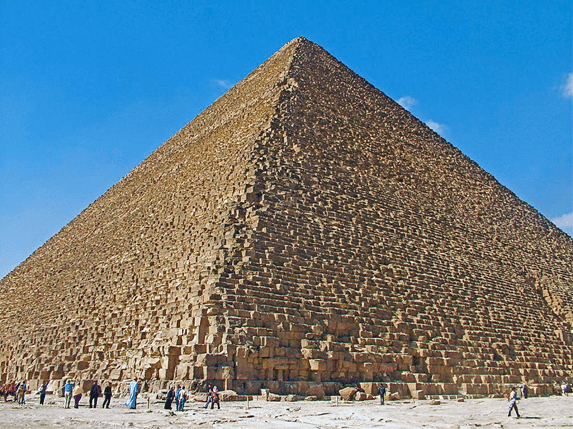


1 Comment. Leave new
Absolutely fasinating! Thanks once again for so clearly showing that a Biblical worldview is well supported by science and archaeology.